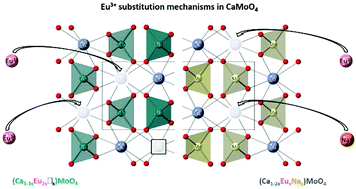Ask for a reprint
email :
2018
ACL
|
A.Isabel Becerro*, M.Allix*, M.Laguna, D.González-Mancebo, C.Genevois, A.Caballero, G.Lozano, N.O.Núñez, M.Ocaña, 'Revealing substitution mechanism in Eu3+:CaMoO4 and Eu3+,Na+:CaMoO4 phosphors.', J. Mater. Chem. C 6 12830 (2018) doi:10.1039/c8tc04595j
Eu3+-doped calcium molybdate is an excellent phosphor for lighting and display devices
due to the very intense pure red emission after UV excitation. It has been reported in the
literature that the CaMoO4 unit cell volume expands after Eu3+ doping, in spite of the
smaller Eu3+ ionic radius compared with Ca2+. Likewise, several studies found that the
emission intensity of the phosphor could be improved by codoping with alkaline ions
like Li+, Na+ or K+. None of these studies correlated the apparent volume expansion and
luminescence enhancement with the crystal structural details. This paper analyses the
aliovalent substitution mechanism and crystal structure of Eu3+:CaMoO4 and
Eu3+,Na+:CaMoO4 phosphors using complementary techniques like Raman
spectroscopy, EXAFS and SPD. We found that the substitution mechanism was
different for both systems, with Ca site vacancies forming in the Eu3+:CaMoO4
phosphors and leading to Ca1-3xEu2x□xMoO4 compositions, while the Eu3+,Na+:CaMoO4
phosphors formed Ca1-2xEuxNaxMoO4. SPD showed that the cell volume expansion
observed with increasing Eu3+ content is related to the increase of the Mo-O bond
distance due to the higher electronegativity of Eu3+ compared with Ca2+. Finally, it was
shown that the luminescence properties, i.e. lifetime values and quantum yields (the
latter reported here for the first time), do not depend on the presence of monovalent ions
in the crystal structure but, exclusively, on the Eu3+ content of the phosphor. The
integral and detailed analysis of the materials presented in this paper, ranging from
crystal structure to luminescent properties including elemental composition allows a full
draw of the structure-properties relationship that had never been addressed before for
CaMoO4-based phopshors.
|

|